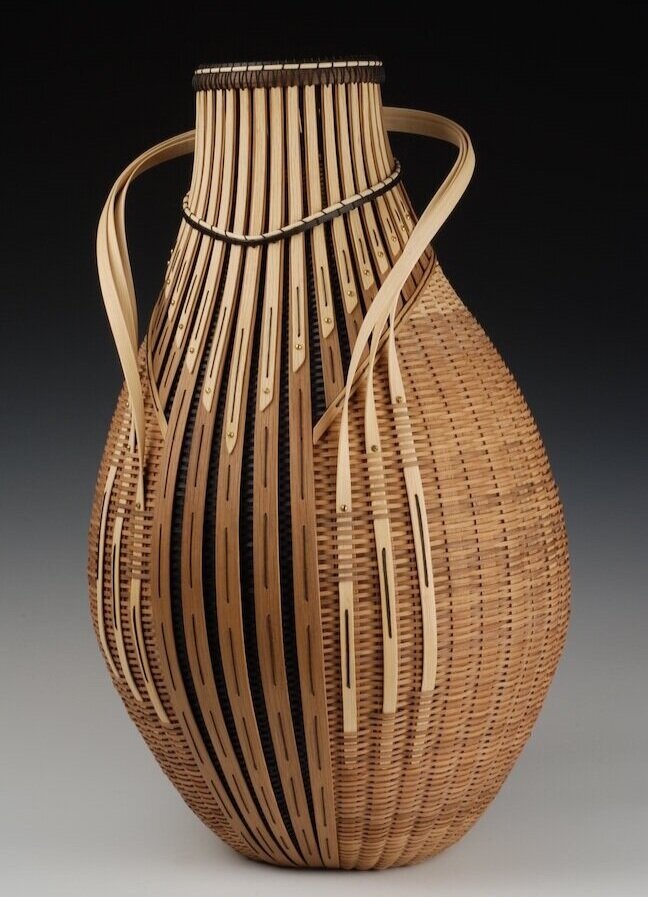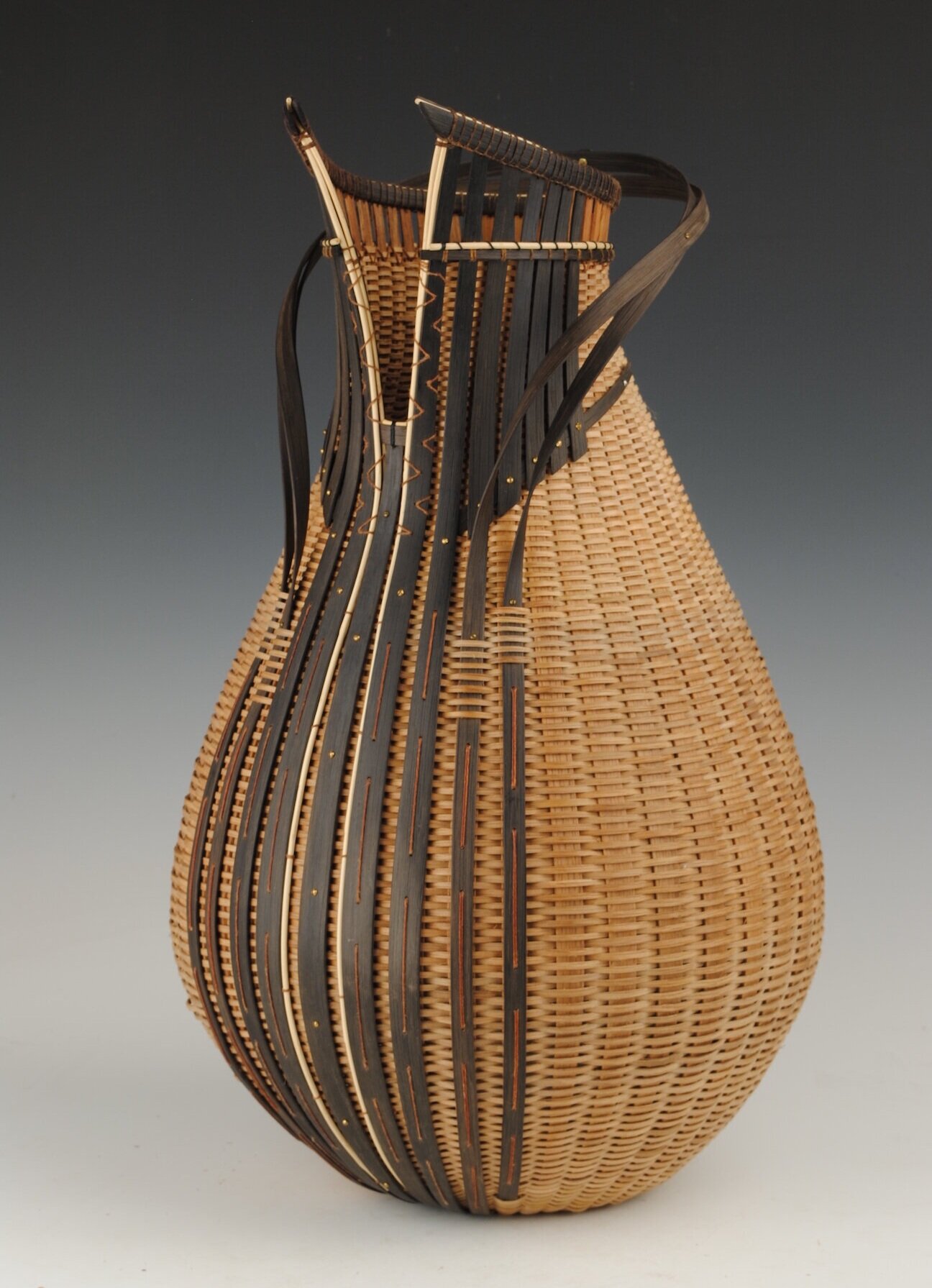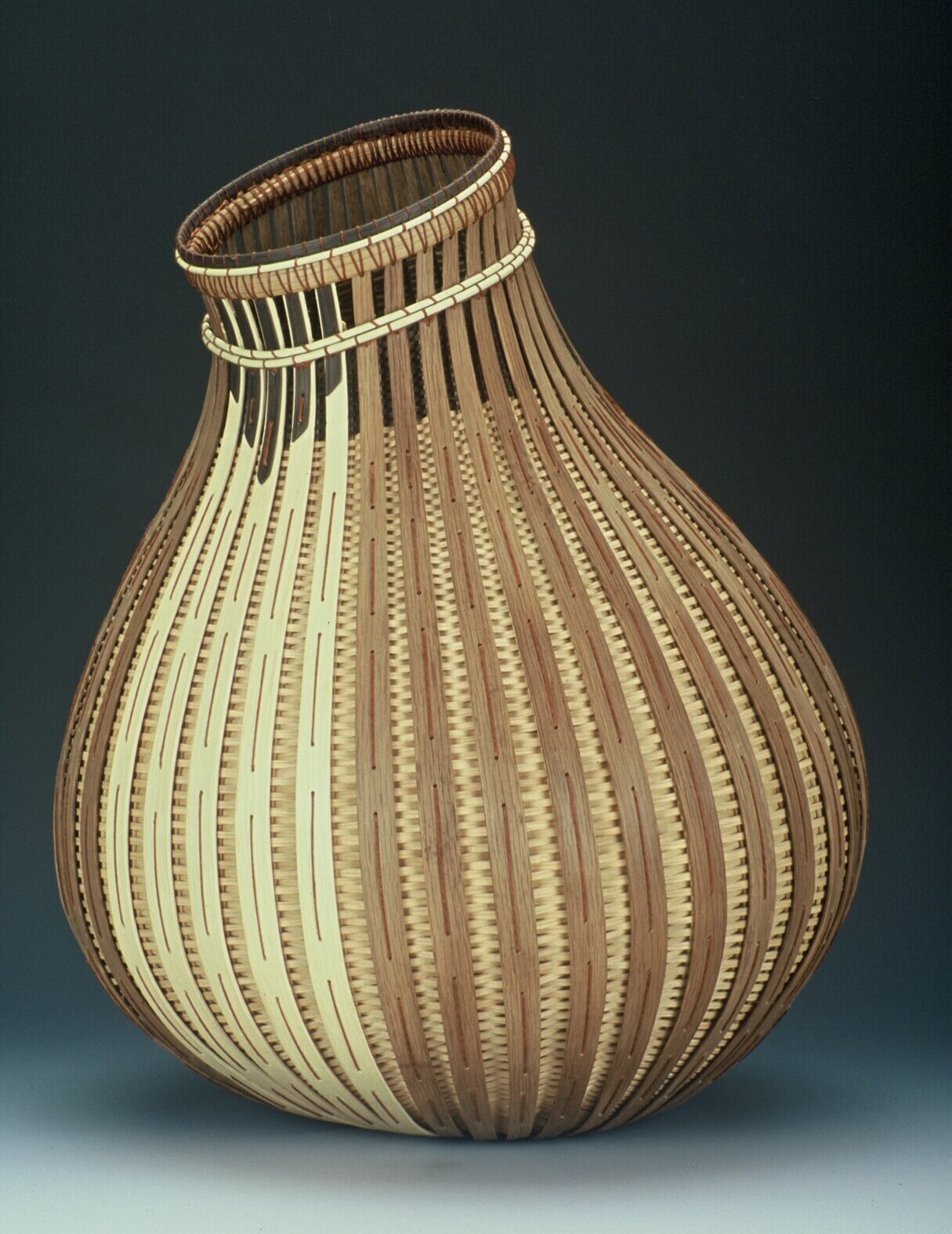Interview with artist Leon Niehues
Leon Niehues is an internationally recognized master basket weaver. He is known for taking a traditional art form to a new level with innovation developed over 30 years. He brings life and personality to simple white oak – where empty space is an integral part of the design and the pleasure in viewing. In 2005, he was named an Arkansas Living Treasure by the Arkansas Arts Council. His baskets are in permanent collections at the Smithsonian Institute, the White House, and in countless museums, and corporate and private collections. If you have ever been to the Crystal Bridges Museum Store, you have seen the influence his artistry. The walls and ceiling of the space were inspired by his basket weaving. Leon’s baskets can be found at the Crystal Bridges Museum Store and at his website.
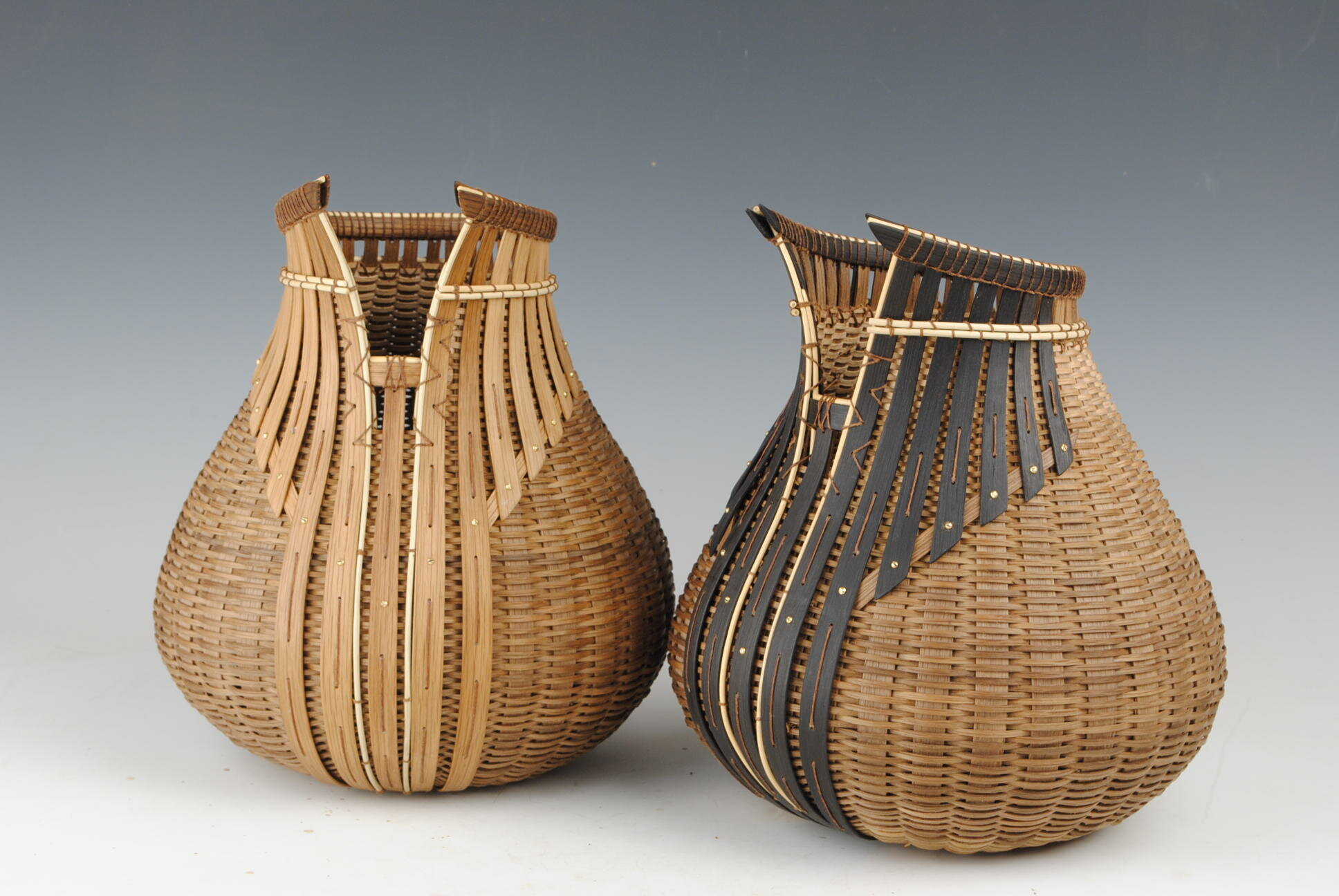
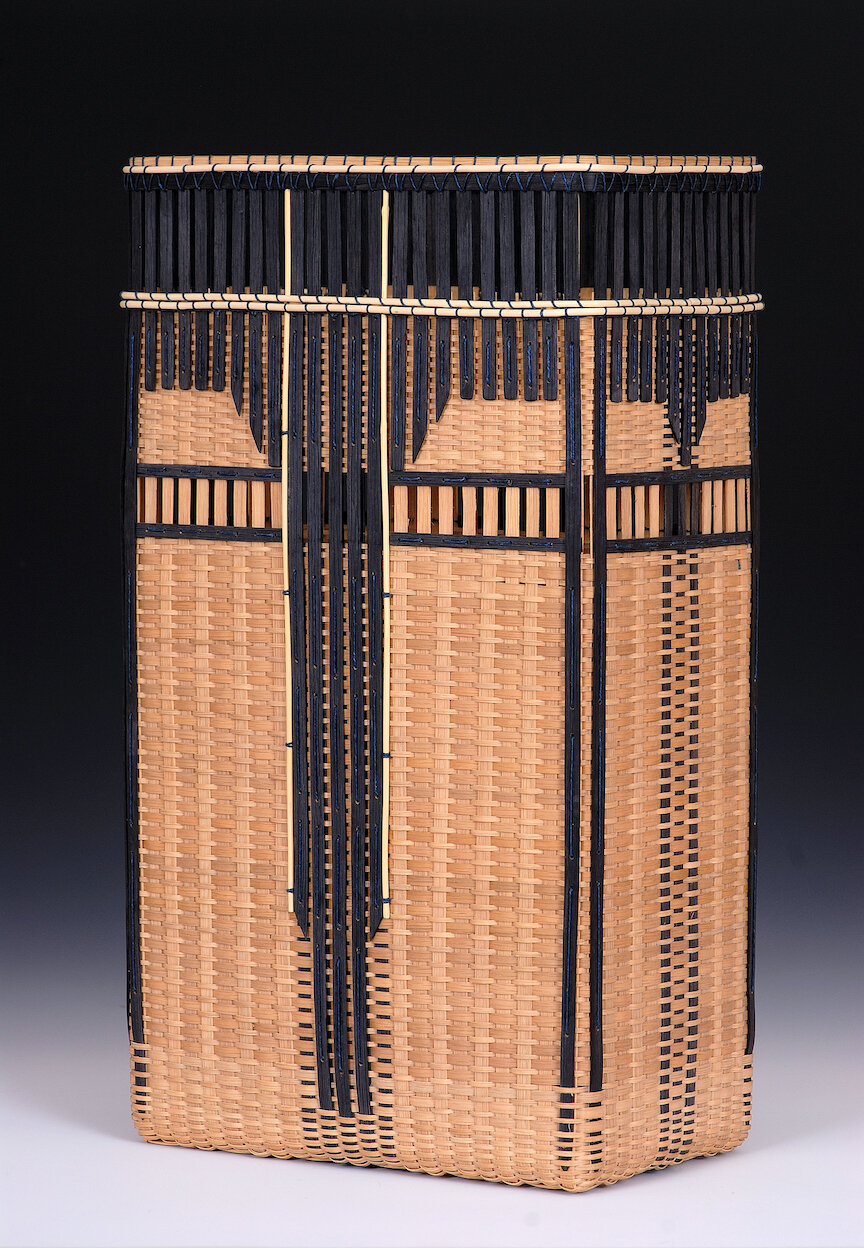
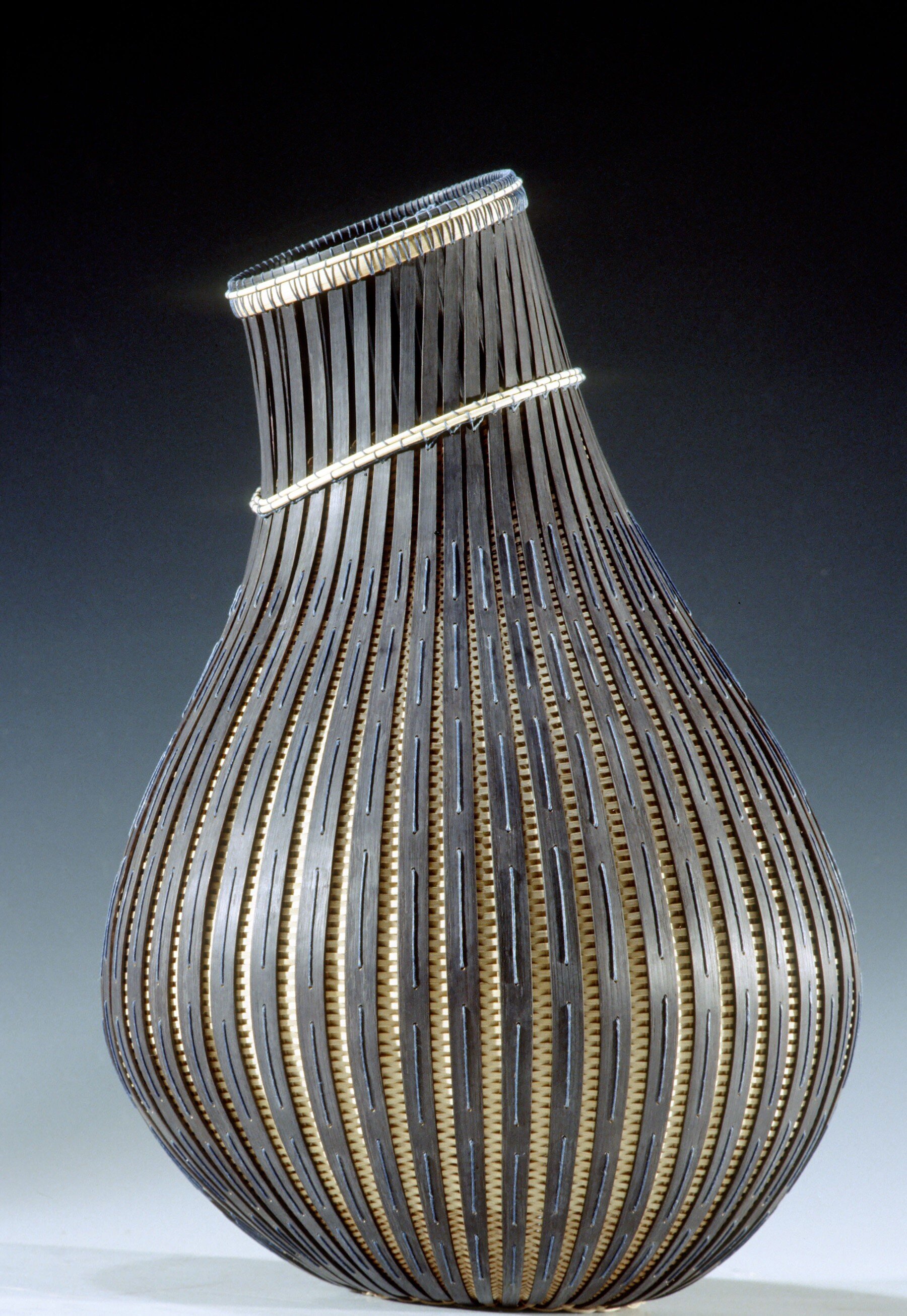
1. AAS: You were born in Kansas and moved later to Huntsville, Arkansas. What was it about the Arkansas Ozarks that drew you there?
LN: When my wife and I were in our early twenties we traveled around a bit. In 1974 we traveled to northwest Arkansas and fell in love with this area and quickly made plans to move here and did so in 1975 with an eight-month-old baby. We were attracted to the unspoiled natural beauty and affordability. And it was an easy drive to Northeast Kansas where most of our family lived.
2. AAS: I guess the obvious question is what made you want to become a basket maker?
LN: Well that was the 1970’s and the counter was in full swing. At the same time there was a renewed interest in craft including glass, ceramics, wood, and even basket making. I became a basket maker because I had always wanted to work with my hands and making baskets from the trees in my 40-acre woods, located just into the Ozark National Forest, had little startup cost. And the idea of the new basket or contemporary basket was just emerging, and we were able to become part of that group right away. We sold our first baskets at War Eagle Fair.
Leon in his home studio.
3. AAS: You are mostly self-taught. What were your inspirations? How do you suggest young people get involved in this art form?
LN: In the mid 1980’s, Shareen LaPlantz began publishing a magazine titled, The News Basket. This magazine, for the first time, cultivated a community of basket artists and introduced me to many basket weavers, both traditional and contemporary. This was before the internet. There were other publications such as Fiber Arts Magazine, which promoted the concept that a basket could be an art object and more than a container, but The News Basket was my window into what we sometimes called the basketry movement. Two inspirations from that time period stand out to this day. I admired the sculptural work of Dorothy Gill Barnes and John McQueen. Both used natural materials from their environment and sculpted objects using basket techniques that I could relate to.
At the same time, I did want to be recognized in the wider world of fine craft and art. Creative basket makers that were featured led me to approach baskets in a creative and innovative manner. I did feel like an outsider in the art world, but I gained confidence and early on began to think of the basket as art object and personal to the maker, especially the relationship toward the choice of materials materials and the environment.
Even now I don’t think basketry-related classes are offered at many universities. Institutions such as Arrowmont and Penland do include basket making in their schedule.
4. You have conducted a number of workshops in basketry for local and national organizations. Is that something you enjoy and is it a way of giving back to the craft and sharing your years of experience?
LN: Lately I have not taught many workshops. I process my own materials, so providing weaving materials for a class requires a lot of prep time and I don’t have as much energy as I used to have. But in the past, it was exciting to travel and be introduced to peers, students, and share ideas for often five days. And I would come home to my Madison county studio energized. Teaching workshops was a way to put my ideas out there and contribute to Basketry on a national scale.
Cowboy, white oak, mini machine screws, 20”H x 12”D
“I use only white oak and it all comes from my 40-acre woods in south Madison county, where we began a back-to-the-land lifestyle in the mid 70’s.”
5. AAS: Your family and especially your wife Sharon has participated in your basket making. Do your children share your love of crafts?
LN: My wife Sharon and three children all worked with me at different times and that has given us an attraction to craft and making. Now I work alone but have a family that is able to give me feedback.
6. AAS: When I look at your creations, I think of woven vessels and woven sculptures, where empty ‘negative’ space is as important as the texture and color of the wood. Would you talk about your design process?
LN: From the beginning I have tried to place my work in the broader world of contemporary craft and not focus my attention on just a basket making community. It is a feeling of being a maker within the broader field of craft. Exploring ceramics was an education in my early years as I see similarities with clay pots and woven pots. Mostly I weave closed forms, meaning the opening is smaller than the base or belly. The interior space is mine and not presented to the viewer. This gives me a surface to work with and I use simple design principles and elements on that surface. Most pieces have a neck and forward lean which imparts a personality and can be a metaphor for approaching each day, as leaning into the day.
Ozark knife method for producing splints for weaving.
7. AAS: You use the Ozark knife technique for splitting wood? Where does the wood for your baskets come from? Would you also describe the preparation of the wood and its rich contrasting colors, which I think are really a recognizable feature of your baskets?
LN: I call it the Ozark knife method for producing splint materials for weaving. Some is written about it in Appalachia though I have never met anyone from that area using the knife method. I made my own splint knife and being self-taught, I have developed my own technique using the knife to produce fine and flexible weaving material. I use only white oak and it all comes from my 40-acre woods in South Madison county. In the last 5 years or so a lot of my healthy white oaks have been dying and I’m not sure the cause, but I am able to harvest them up to a year after they die. I use only the blemish free butt cuts from young trees with a length of around 60”. I prefer to harvest wood in the fall and winter when the sap is low. Each tree seems to have its own personality and often the log will be hard to split or not cut smoothly with my splint knife. I can use the waste for firewood.
First, I split the log lengthwise with a maul and wedges into as many as 16 pieces. I square the billet up a bit by splitting the inner heart off with a froe and shaping the remaining wood with a drawn knife. When I need fine and thin weaving material, I run that billet through a band saw to give me a “board” that is true quarter sawn with all the growth rings running parallel with each other. My splint knife has two handles with a blade in the middle and the idea is to cut off a layer that is a growth ring. I use scissors to cut and rip the weaves into smaller weaving strips. This isn’t an easy process and took me a long time to master.
I use a much simpler method to produce heavier wood for bending and overlays. After the wood is split, cut to length, and often shaped, I separate the growth rings with kitchen knives. The knife is dull because I use it to split and not to cut. White oak is one of the woods that layers will separate if you choose the right tree. After I have split it into growth ring thicknesses I again shape and dress both sides with a drawknife which is sharp. Thickness of growth rings vary from layer to layer and so I have different thicknesses to work with. A wood splint produced this way is very strong and pliable because we are using only the dense summer growth and not the porous spring growth. Both these methods are often called green woodworking.
“One reason I think my work is attractive to the viewer is because it is old and new at the same time.”
8. AAS: Have you always done Bentwood Sculptural Spheres or is this form relatively new for you. I think they are a superb example of how you use negative space to define a shape.
Bentwood sculpture detail, white oak with natural dyes, mini machine screws
LN: The first bentwood sculptural works were finished in 2002 for a national exhibition curated by Alan DuBois titled “Baskets Now: USA” at the Arkansas Arts Center. I constructed two pieces that were radically different from my woven baskets using a bentwood skeleton and 3-M black emery cloth for a skin. I didn’t come back to this idea until 2007. I wanted to reinvent myself somewhat and find a new audience. For a period of five months I made a point to not let myself enter my studio and weave baskets. So I came-up with a lot of interesting work, bending wood free-hand, often using 3-M emery cloth, stitching wood together with linen thread, and using lots of little machine screws for connections. The work became open and sculpted but I think still relates to baskets.
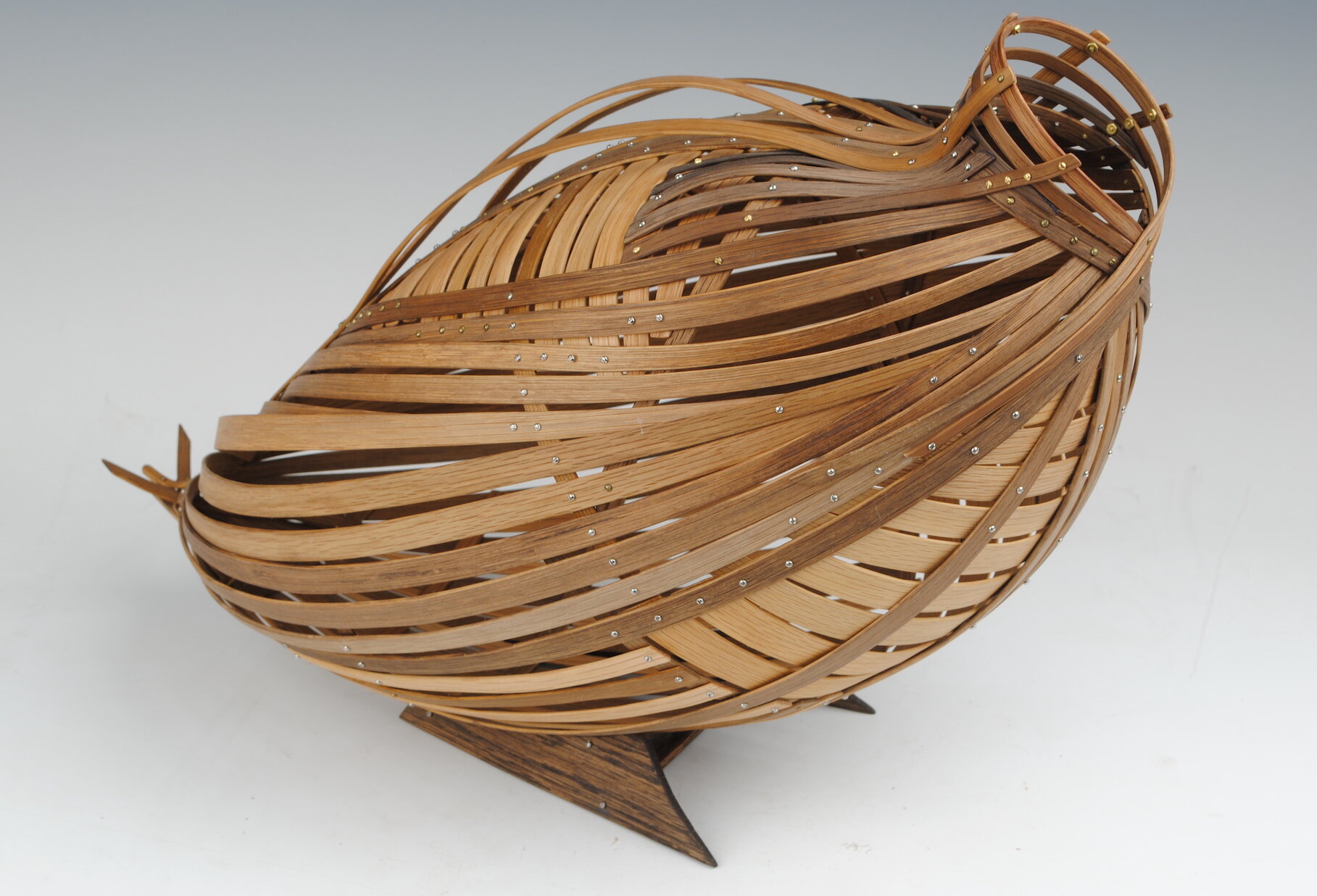
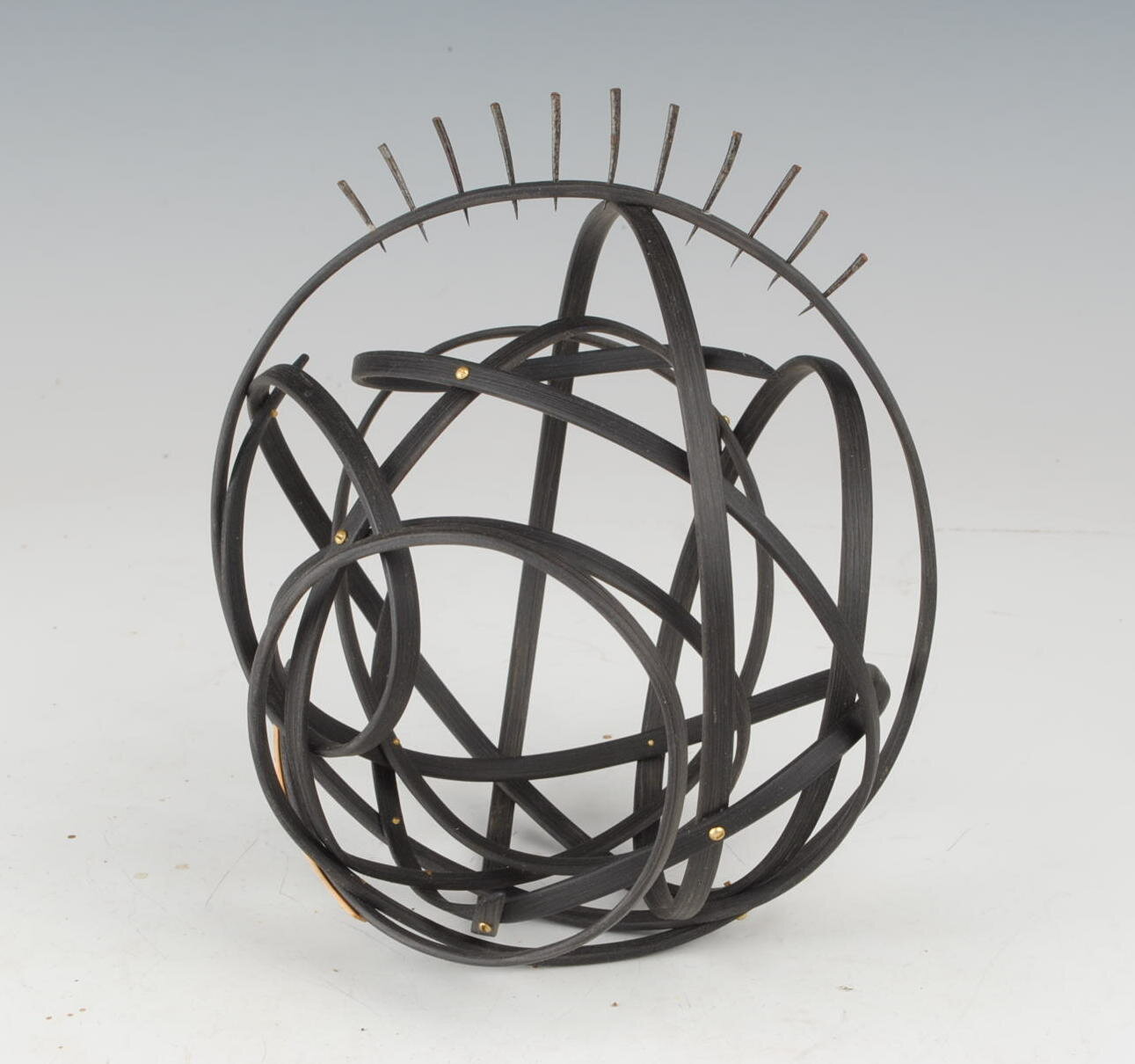
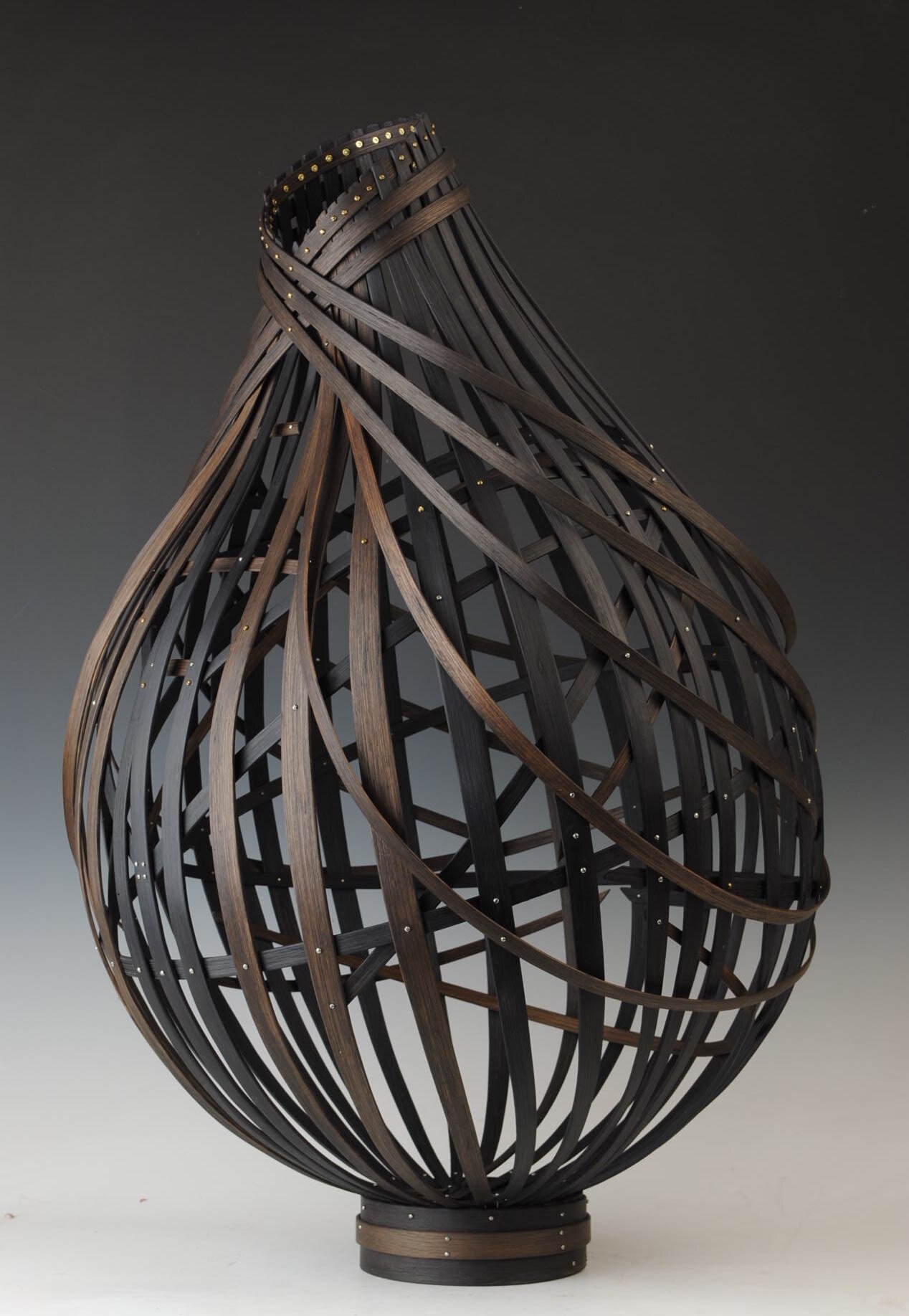
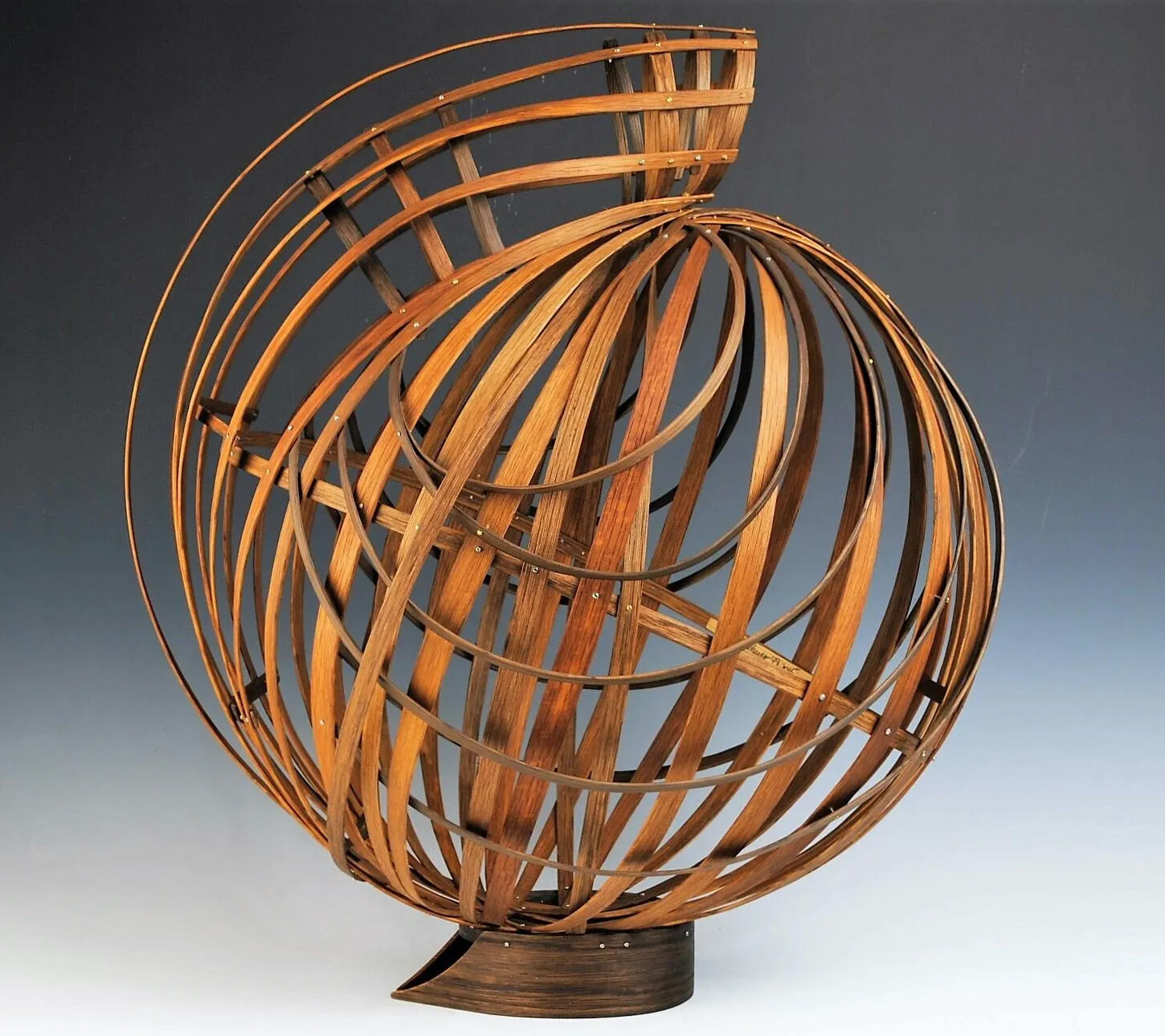
Bentwood Sculpture Military Dress, white oak darken with walnut hull dye and iron, brass and stainless steel mini machine screws, 26”H 20”D
9. AAS: I especially love the way you bring ‘fashion’ to your baskets. Your Military Dress Baskets are wonderful! And your Tuxedo Open Collar baskets are iconic.
LN: I refer back to these baskets as having a personality. They have a posture and face the viewer so they lend themselves to dressing the surface. For the last 15 years or more my color palette has consisted of natural shades of wood to almost black. I use only natural dyes because I think they complement the wood I use and I can feel safe about handling them often. I collect black walnuts in the fall and winter, strip off the hulls, and store them under my studio porch in a large plastic bucket covered with a lid. By adding a little water and sometimes heating the soup I get a permanent dye with shades of brown depending on how long I leave the wood immersed. The other dye I use is ferrous sulfate and often refer to it as iron. In a mild solution it will darken acidic woods such as white oak immediately. Often I dye with walnut hulls for 24 hours and then immerse in the iron solution to get darker browns and black.
“Most pieces have a neck and forward lean which imparts a personality and can be a metaphor for approaching each day, as leaning into the day.”
10. AAS: You have earned so many prestigious local, national and international awards, notably the 2005 Arkansas Living Treasure award from the Arkansas Arts Council, the 2013 James Renwick Alliance Distinguished Artist Award (Washington, DC), and in 2012 a United States Artist Fellowship, USA Windgate Fellowship. Has this recognition influenced the art you choose to make, or are you self-determined and exploring new expression of this art form?
LN: The award that had the most influence and really established me as a national craft artist was the White House Craft Collection, Washington DC, in 1993. This and other awards introduced me to a new group of collectors that in turn gave me the opportunity to craft unique pieces for them. I still don’t take commissions but make baskets and hopefully find a home for them.
Asian Bird, white oak with 3-M emery cloth, mini machine screws, 16”H x 11”D
11. AAS: In addition to the Presidential White House Craft Collection, you are part of the permanent collection of the Renwick Gallery at the Smithsonian American Art Museum, Washington, DC. This must bring you much personal satisfaction as well as pride in representing a traditional Arkansas craft.
LN: I am proud to be from Arkansas and to have work represented in national collections but it is not part of my day to day life.
12. AAS: What are the roots of your style of weaving?
LN: I had no traditional roots to begin with. And I didn’t want to borrow another group’s traditions so I found my own way. Early on it was all about form, simple weaving, over and under.
13. AAS: You are recognized as a leading voice of Ozark Basketry. In fact, one of your spheres is on the cover of the reference book Rooted, Revived, Reinvented: Basketry in America 2017.
LN: I love being on the cover of that book and have never asked how they choose my work for the cover. It is a very open bentwood sphere. Rooted, Revived, Reinvented: Basketry in America chronicles a history of American basketry in Native American, immigrant, and slave communities to its presence within the contemporary art world.
Warrior, white oak, 3-M emery cloth, brass mini screws, 17”H x 15”D
14. AAS: In your mind, do you think there was one seminal piece that defined your trajectory to ultimately be exhibited from California and Seattle to Tokyo and represented by galleries in New York and Connecticut?
LN: No, I don’t think there was any one work. But I do think the basket in the White House Craft Collection helped make my work very recognizable from coast to coast and people could recognize a Niehues basket. Later there were works that were featured like Warrior, using bentwood and 3-M emery cloth skin, that made that work easily identifiable to me and more recently the Bentwood Sphere on the cover of the Rooted, Revived, Reinvented book [and profile photo].
15. AAS: Where do you see basketry as an art form headed? Do you meet many young people interested in basketry?
LN: I don’t see many young people interested in making baskets compared to ceramics, jewelry, etc. But young people are into making things and weaving is easy to incorporate into all craft media. Weaving in general is very popular in the broader world of design.
